
Mammals of New England
Encyclopedia
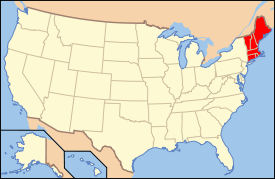
Maine
Maine is a state in the New England region of the northeastern United States, bordered by the Atlantic Ocean to the east and south, New Hampshire to the west, and the Canadian provinces of Quebec to the northwest and New Brunswick to the northeast. Maine is both the northernmost and easternmost...
, New Hampshire
New Hampshire
New Hampshire is a state in the New England region of the northeastern United States of America. The state was named after the southern English county of Hampshire. It is bordered by Massachusetts to the south, Vermont to the west, Maine and the Atlantic Ocean to the east, and the Canadian...
, Vermont
Vermont
Vermont is a state in the New England region of the northeastern United States of America. The state ranks 43rd in land area, , and 45th in total area. Its population according to the 2010 census, 630,337, is the second smallest in the country, larger only than Wyoming. It is the only New England...
, Massachusetts
Massachusetts
The Commonwealth of Massachusetts is a state in the New England region of the northeastern United States of America. It is bordered by Rhode Island and Connecticut to the south, New York to the west, and Vermont and New Hampshire to the north; at its east lies the Atlantic Ocean. As of the 2010...
, Connecticut
Connecticut
Connecticut is a state in the New England region of the northeastern United States. It is bordered by Rhode Island to the east, Massachusetts to the north, and the state of New York to the west and the south .Connecticut is named for the Connecticut River, the major U.S. river that approximately...
, and Rhode Island
Rhode Island
The state of Rhode Island and Providence Plantations, more commonly referred to as Rhode Island , is a state in the New England region of the United States. It is the smallest U.S. state by area...
.
The makeup and distribution of the mammals in New England are largely the result of the Last Glacial Maximum
Last Glacial Maximum
The Last Glacial Maximum refers to a period in the Earth's climate history when ice sheets were at their maximum extension, between 26,500 and 19,000–20,000 years ago, marking the peak of the last glacial period. During this time, vast ice sheets covered much of North America, northern Europe and...
when the Laurentide ice sheet
Laurentide ice sheet
The Laurentide Ice Sheet was a massive sheet of ice that covered hundreds of thousands of square miles, including most of Canada and a large portion of the northern United States, multiple times during Quaternary glacial epochs. It last covered most of northern North America between c. 95,000 and...
covered virtually the entire region. Recolonization of the area appears to have occurred from one or a few southern glacial refugia. This is in contrast to the multiple glacial refugia present throughout the American West (Stone and Cook, 2000). As a consequence of both the recent uninhabitability and the few sources of recolonization, species diversity
Species diversity
Species diversity is an index that incorporates the number of species in an area and also their relative abundance. It is a more comprehensive value than species richness....
for some taxa in parts of New England are lower than in similar areas in other parts of North America. Chipmunk
Chipmunk
Chipmunks are small striped squirrels native to North America and Asia. They are usually classed either as a single genus with three subgenera, or as three genera.-Etymology and taxonomy:...
s and ground squirrel
Ground squirrel
The ground squirrels are members of the squirrel family of rodents which generally live on or in the ground, rather than trees. The term is most often used for the medium-sized ground squirrels, as the larger ones are more commonly known as marmots or prairie dogs, while the smaller and less...
s are exemplars of this situation. New England has one species of each, but numerous locations west of the Rocky Mountains
Rocky Mountains
The Rocky Mountains are a major mountain range in western North America. The Rocky Mountains stretch more than from the northernmost part of British Columbia, in western Canada, to New Mexico, in the southwestern United States...
host several species (Hall, 1981).
Habitat varies throughout the region. Maine, New Hampshire, and Vermont, in the north of the region, have a humid continental short summer climate, with cooler summers and long, cold winters. Massachusetts, Connecticut, and Rhode Island, in the south, have a humid continental long summer climate, with hot summers and cold winters. The average rainfall for most of the region is from 1,000 to 1,500 mm (40 to 60 in) a year, although the northern parts of Vermont and Maine see slightly less, from 500 to 1,000 mm (20 to 40 in). Snowfall can often exceed 2,500 mm (100 in) annually (New England Climate Initiative, 2006). Most mammals in this region exhibit specializations for dealing with the sometimes harsh winter conditions.
A comprehensive listing of all species found in the region follows.
Opossums, order DidelphimorphiaDidelphimorphiaOpossums make up the largest order of marsupials in the Western Hemisphere, including 103 or more species in 19 genera. They are also commonly called possums, though that term technically refers to Australian fauna of the suborder Phalangeriformes. The Virginia opossum was the first animal to be...
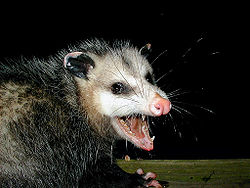
Virginia opossumVirginia OpossumThe Virginia opossum , commonly known as the North American opossum or tlacuache in Mexico, is the only marsupial found in North America north of Mexico. A solitary and nocturnal animal about the size of a domestic cat, and thus the largest opossum, it is a successful opportunist...
, Didelphis virginiana
- Distribution: Southern New Hampshire, Southern Maine, southern Vermont, Massachusetts, Connecticut, and Rhode Island.
- Subspecies: Didelphis virginiana virginiana according to Hall (1981) and Whitaker and Hamilton (1998).
Masked ShrewMasked ShrewThe Cinereus Shrew or Masked Shrew is a small shrew found in Alaska, Canada and the northern United States. This is the most widely distributed shrew in North America where it is also known as the Common Shrew.- Description :...
, Sorex cinereus
- Distribution: Maine, New Hampshire, Vermont, Massachusetts, Connecticut, and Rhode Island.
- Subspecies: Sorex cinereus cinereus according to Hall (1981) and Whitaker and Hamilton (1998).
Long-tailed ShrewLong-tailed ShrewThe Long-tailed Shrew or Rock Shrew is a small North American shrew found in Atlantic Canada and the north-eastern United States....
, Sorex dispar
- Distribution: Northwestern Maine, all but southeastern New Hampshire, all but northeastern Vermont, western Massachusetts, and western Connecticut.
- Subspecies: Sorex dispar dispar according to Hall (1981) and Whitaker and Hamilton (1998).
Smoky ShrewSmoky ShrewThe Smoky Shrew, Sorex fumeus, is a medium-sized North American shrew found in eastern Canada and the northeastern United States.It is dull grey in colour with lighter underparts and a long tail which is brown on top and yellowish underneath. During winter, its fur is grey...
, Sorex fumeus

- Distribution: Maine, New Hampshire, Vermont, Massachusetts, Connecticut, and Rhode Island.
- Subspecies: Sorex fumeus umbrosus (all but southernmost Maine, northernmost New Hampshire, and northern Vermont) and Sorex fumeus fumeus (southernmost Maine, central and southern New Hampshire, southern Vermont, Massachusetts, Connecticut, and Rhode Island) according to Hall (1981). Whitaker and Hamilton (1998) do not recognize S. f. umbrosus as a valid subspecies and consider all New England Sorex fumeus to be S. f. fumeus. Hutterer (2005), however, recognizes S. f. umbrosus as a valid subspecies.
Pygmy Shrew, Sorex hoyi
- Distribution: All but the southern tip of Maine, central and northern New Hampshire, and all but southeastern Vermont.
- Subspecies: Sorex hoyi thompsoni according to Hall (1981) and Whitaker and Hamilton (1998).
American Water ShrewAmerican Water ShrewThe American Water Shrew or Northern Water Shrew, is a large North American shrew found in aquatic habitats. Some sources include the Glacier Bay Water Shrew, S. alaskanus, within this species....
, Sorex palustris
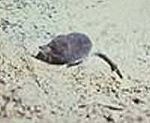
- Distribution: Maine, New Hampshire, Vermont, Massachusetts, Connecticut, and Rhode Island.
- Subspecies: Sorex palustris gloveralleni (easternmost Maine) and Sorex palustris albibarbis (all but easternmost Maine, New Hampshire, Vermont, Massachusetts, Connecticut, Rhode Island) according to Hall (1981). Whitaker and Hamilton (1998) argue that both S. p. gloveralleni and S. p. albibarbis are not valid subspecies and all New England forms belong to the subspecies Sorex palustris palustris. Hutterer (2005), however, treats S. p. gloveralleni and S. p. albibarbis as valid subspecies.
Northern Short-tailed ShrewNorthern Short-tailed ShrewThe Northern Short-tailed Shrew is the largest shrew in the genus Blarina, and occurs in the northeastern region of North America. It is a semifossorial, highly active and voracious insectivore and is present in a variety of habitats. It is notable in that it is one of the few venomous mammals...
, Blarina brevicauda

- Distribution: Maine, New Hampshire, Vermont, Massachusetts, Connecticut, and Rhode Island.
- Subspecies: Blarina brevicauda angusta (northern Maine), Blarina brevicauda pallida (north-central Maine), Blarina brevicauda hooperi (northern Green Mountains, Vermont), Blarina brevicauda talpoides (southern and central Maine, New Hampshire, most of Vermont, Massachusetts, Connecticut, and Rhode Island), Blarina brevicauda compacta (Nantucket Island), and Blarina brevicauda aloga (Martha's Vineyard) according to Hall (1981). Whitaker and Hamilton (1998) argue that B. b. angusta, B. b. pallida, B. b. hooperi, and B. b. talpoides are not valid subspecies and should be synonymized with Blarina brevicauda brevicauda. Hutterer (2005), however, recognizes all of these as valid subspecies.
Hairy-tailed MoleHairy-tailed MoleThe Hairy-tailed Mole , also known as Brewer's Mole, is a medium-sized North American mole. It is the only member of the genus Parascalops....
, Parascalops breweri
- Distribution: Maine, New Hampshire, Vermont, Massachusetts, northern and western Connecticut, and Rhode Island.
Eastern MoleEastern MoleThe eastern mole or common mole is a medium-sized, overall grey North American mole and the only member of the genus Scalopus. Its large, hairless, spade shaped forefeet are adapted for digging...
, Scalopus aquaticus
- Distribution: Central and southern Massachusetts, Connecticut, and Rhode Island.
- Subspecies: Scalopus aquaticus aquaticus according to Hall (1981) and Whitaker and Hamilton (1998).
Star-nosed MoleStar-nosed moleThe star-nosed mole is a small mole found in wet low areas of eastern Canada and the north-eastern United States, with records extending along the Atlantic coast as far as extreme southeastern Georgia...
, Condylura cristata

- Distribution: Maine, New Hampshire, Vermont, Massachusetts, Connecticut, and Rhode Island.
- Subspecies: Condylura cristata cristata according to Hall (1981) and Whitaker and Hamilton (1998).
Eastern Small-footed Bat, Myotis leibii
- Distribution: Central Maine, central New Hampshire, central Vermont.
- Status: Endangered in New Hampshire; Threatened in Vermont (Whitaker and Hamilton, 1998).
Little Brown BatLittle brown batThe little brown bat is a species of the genus Myotis , one of the most common bats of North America...
, Myotis lucifugus
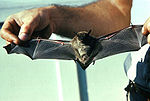
- Distribution: Maine, New Hampshire, Vermont, Massachusetts, Connecticut, and Rhode Island.
- Subspecies: Myotis lucifugus lucifugus according to Hall (1981) and Whitaker and Hamilton (1998).
Northern Long-eared BatNorthern Long-eared BatThe Northern Long-Eared Bat is a species of vesper bat in the Vespertilionidae family.It is found only in Australia.-References:* Chiroptera Specialist Group 1996. . Downloaded on 9 July 2007....
, Myotis septentrionalis
- Distribution: Maine, New Hampshire, Vermont, Massachusetts, Connecticut, and Rhode Island.
Indiana BatIndiana batThe Indiana bat is a medium-sized mouse-eared bat native to North America. It lives primarily in eastern and midwestern states and in parts of the south of the United States. The Indiana bat is gray, black, or chestnut in colour and is 1.2–2 inches and weighs about 1/4 an ounce...
, Myotis sodalis

- Distribution: Southeastern and central New Hampshire, southern and central Vermont, western and central Massachusetts, all but southern Connecticut, northeastern Rhode Island.
- Status: Federally EndangeredUnited States Fish and Wildlife Service list of endangered speciesThis list contains only the bird and mammal species described as endangered by the United States Fish and Wildlife Service. It contains species not only in the U.S. and its territories, but also species only found abroad. It does not contain fish, amphibians, reptiles, plants, or invertebrates,...
(Whitaker and Hamilton, 1998).
Silver-haired BatSilver-Haired BatThe Silver-haired Bat is a species of vesper bat in the family Vespertilionidae and the only member of the genus Lasionycteris.- Habitat :...
, Lasionycteris noctivagans
- Distribution (summer): Maine, New Hampshire, Vermont, northern and central Massachusetts.
- Distribution (winter): southeastern Connecticut.
Eastern PipistrelleEastern PipistrelleThe Tricolored Bat is a species of bat that is widely distributed throughout the eastern parts of North America, ranging west until Kansas and Texas, from Honduras up north until southern Ontario...
, Perimyotis subflavus
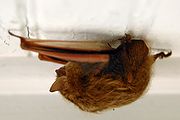
- Distribution southern New Hampshire, all but northeastern Vermont, Massachusetts, Connecticut, and Rhode Island.
- Subspecies: Perimyotis subflavus subflavus according to Hall (1981) and Whitaker and Hamilton (1998).
Big Brown BatBig brown batThe Big Brown Bat is larger in size than comparative species of bats, from about 4 to 5 inches in body length, with a 11-13 inch wingspan and weighing 1/2 to 5/8 ounce. The fur is moderately long, and shiny brown...
, Eptesicus fuscus
- Distribution: Maine, New Hampshire, Vermont, Massachusetts, Connecticut, and Rhode Island.
- Subspecies: Eptesicus fuscus fuscus according to Hall (1981) and Whitaker and Hamilton (1998).
Eastern Red BatEastern Red BatThe Eastern Red Bat is a species of bat from the family Vespertilionidae. See also the Desert red bat , a related species....
, Lasiurus borealis
- Distribution (summer): Maine, New Hampshire, Vermont, Massachusetts, Connecticut, and Rhode Island.
- Subspecies: Lasiurus borealis borealis according to Hall (1981) and Whitaker and Hamilton (1998).
Hoary BatHoary batThe hoary bat is a species of bat in the vesper bat family, Vespertilionidae. It occurs throughout most of North America and much of South America, with disjunct populations in the Galapagos and Hawaiian Islands...
, Lasiurus cinereus
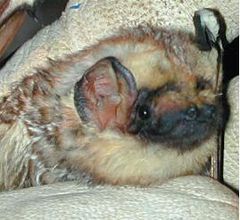
- Distribution (summer, predominantly females): northern Maine, all but southeastern New Hampshire, Vermont.
- Subspecies: Lasiurus cinereus cinereus according to Hall (1981) and Whitaker and Hamilton (1998).
Eastern CottontailEastern CottontailThe eastern cottontail is a New World cottontail rabbit, a member of the family Leporidae. It is one of the most common rabbit species in North America.-Distribution:...
, Sylvilagus floridanus
- Distribution: southern New Hampshire, all but northeastern Vermont, Massachusetts, Connecticut, and Rhode Island.
- Subspecies: Sylvilagus floridanus mallurus (southern New Hampshire, southeastern Vermont, Massachusetts, Connecticut, and Rhode Island) and Sylvilagus floridanus mearnsi (central and western Vermont) according to Hall (1981). Whitaker and Hamilton (1998) argue that both S. f. mallurus and S. f. mearnsi are not valid subspecies and should be synonymized with Sylvilagus floridanus floridanus. Hoffman and Smith (2005), however, recognize both S. f. mallurus and S. f. mearnsi as valid subspecies.
New England CottontailNew England CottontailThe New England Cottontail is a species of cottontail rabbit represented by fragmented populations in areas of New England, specifically from southern Maine to southern New York...
, Sylvilagus transitionalis
- Distribution: southernmost Maine, central and southern New Hampshire, all but northeastern Vermont, Massachusetts, Connecticut, Rhode Island.
Snowshoe HareSnowshoe HareThe Snowshoe Hare , also called the Varying Hare, or Snowshoe Rabbit, is a species of hare found in North America. It has the name "snowshoe" because of the large size of its hind feet and the marks its tail leaves. The animal's feet prevent it from sinking into the snow when it hops and walks...
, Lepus americanus
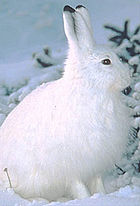
- Distribution: all but the southern tip of Maine, all but southeastern New Hampshire, Vermont, and northeastern Massachusetts.
- Subspecies: Lepus americanus struthopus (northern Maine) and Lepus americanus virginianus (central Maine, all but southeastern New Hampshire, Vermont, and northeastern Massachusetts) according to Hall (1981). Whitaker and Hamilton (1998) argue that both L. a. struthopus and L. a. virginianus are not valid subspecies and should be synonymized with Lepus americanus americanus. Hoffman and Smith (2005), however, recognize both L. a. struthopus and L. a. virginianus as valid subspecies.
European HareEuropean HareThe European hare , also known as the brown hare, Eastern Jackrabbit and Eastern prairie hare, is a species of hare native to northern, central, and western Europe and western Asia. It is a mammal adapted to temperate open country. It is related to the similarly appearing rabbit, which is in the...
, Lepus europaeus (introduced)
- Distribution (persistence of population is in dispute): southeasternmost corner of Massachusetts and central and western Connecticut.
Rodents, order RodentRodentRodentia is an order of mammals also known as rodents, characterised by two continuously growing incisors in the upper and lower jaws which must be kept short by gnawing....
ia
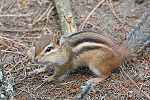
Eastern ChipmunkEastern ChipmunkThe eastern chipmunk is a small squirrel-like rodent found in eastern North America, the sole living member of the chipmunk genus and subgenus Tamias....
, Tamias striatus
- Distribution: Maine, New Hampshire, Vermont, Massachusetts, Connecticut, and Rhode Island.
- Subspecies: Tamias striatus lysteri (Maine, New Hampshire, Vermont, most of Massachusetts, northeastern Connecticut, and northern Rhode Island) and Tamias striatus fisheri (extreme southern Massachusetts, southern and central Connecticut, southern Rhode Island) according to Hall (1981). Whitaker and Hamilton (1998) argue that both T. s. lysteri and T. s. fisheri are not valid subspecies and should be synonymized with Tamias striatus striatus. Thorrington and Hoffman (2005), however, recognize both T. s. lysteri and T. s. fisheri as valid subspecies.
WoodchuckGroundhogThe groundhog , also known as a woodchuck, whistle-pig, or in some areas as a land-beaver, is a rodent of the family Sciuridae, belonging to the group of large ground squirrels known as marmots. Other marmots, such as the yellow-bellied and hoary marmots, live in rocky and mountainous areas, but...
, Marmota monax

- Distribution: Maine, New Hampshire, Vermont, Massachusetts, Connecticut, and Rhode Island.
- Subspecies: Marmota monax canadensis (northern Maine, northern Vermont), Marmota monax rufescens (extreme western Maine, northern and southwestern New Hampshire, north central and southern Vermont, western Massachusetts, and southwestern Connecticut)), and Marmota monax preblorum (central and southern Maine, central and southeastern New Hampshire, west central Vermont, eastern Massachusetts, northwestern Connecticut, and Rhode Island) according to Hall (1981). Whitaker and Hamilton (1998) argue that M. m. canadensis and M. m. rufescens, and M. m. preblorum are not valid subspecies and should be synonymized with Marmota monax monax. Thorrington and Hoffman (2005), however, recognize M. m. canadensis and M. m. rufescens, but not M. m. preblorum, as valid subspecies.
Eastern Gray SquirrelEastern Gray SquirrelThe eastern gray squirrel is a tree squirrel in the genus Sciurus native to the eastern and midwestern United States, and to the southerly portions of the eastern provinces of Canada...
, Sciurus carolinensis
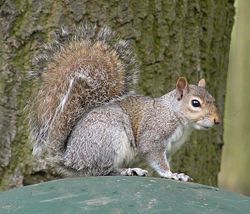
- Distribution: central and southern Maine, New Hampshire, Vermont, Massachusetts, Connecticut, and Rhode Island.
- Subspecies: Sciurus carolinensis pennsylvanicus according to Hall (1981) and Thorrington and Hoffman (2005). Whitaker and Hamilton (1998) do not recognize S. c. pennsylvanicus as distinct from Sciurus carolinensis.
American Red SquirrelAmerican Red SquirrelThe American Red Squirrel is one of three species of tree squirrel currently classified in the genus Tamiasciurus and known as pine squirrels...
, Tamiasciurus hudsonicus
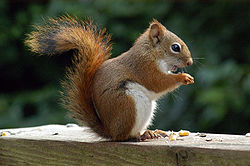
- Distribution: Maine, New Hampshire, Vermont, Massachusetts, Connecticut, and Rhode Island.
- Subspecies: Tamiasciurus hudsonicus gymnicus (Maine, all but southeasternmost New Hampshire, central and western Vermont) and Tamiasciurus hudsonicus loquax (western Vermont, Massachusetts, Connecticut, and Rhode Island) according to Hall (1981). Whitaker and Hamilton (1998) argue that both T. h. gymnicus and T. h. loquax are not valid subspecies and should be synonymized with Tamiasciurus hudsonicus hudsonicus. Thorrington and Hoffman (2005), however, recognize both T. h. gymnicus and T. h. loquax as valid subspecies.
Northern Flying SquirrelNorthern Flying SquirrelThe Northern flying squirrel is one of two species of the genus Glaucomys, the only flying squirrels found in North America . Unlike most members of their family, flying squirrels are strictly nocturnal...
, Glaucomys sabrinus
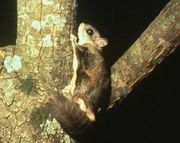
- Distribution: Maine, New Hampshire, Vermont, western and central Massachusetts, and northwestern Connecticut.
- Subspecies: Glaucomys sabrinus macrotis according to Hall (1981) and Thorrington and Hoffman (2005). Whitaker and Hamilton (1998) do not recognize G. s. macrotis as distinct from Glaucomys sabrinus sabrinus.
Southern Flying SquirrelSouthern Flying SquirrelThe Southern Flying Squirrel is one of two species of the genus Glaucomys, the only flying squirrels found in North America . It is found in deciduous and mixed woods in the eastern half of North America, from southeastern Canada, to Florida, USA...
, Glaucomys volans

- Distribution: southern Maine, all but northernmost New Hampshire, Vermont, Massachusetts, Connecticut, and Rhode Island.
- Subspecies: Glaucomys volans volans according to Hall (1981) and Whitaker and Hamilton (1998).
Beavers, family CastoridaeCastoridaeThe family Castoridae contains the two living species of beaver and their fossil relatives. This was once a highly diverse group of rodents, but is now restricted to a single genus, Castor.- Characteristics :...
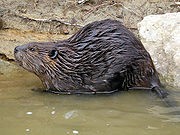
American BeaverAmerican BeaverThe North American Beaver is the only species of beaver in the Americas, native to North America and introduced to South America. In the United States and Canada, where no other species of beaver occurs, it is usually simply referred to as "beaver"...
, Castor canadensis
- Distribution: Maine, New Hampshire, Vermont, Massachusetts, Connecticut, and Rhode Island.
- Subspecies: Neither Helgen (2005) not Whitaker and Hall (1998) recognize any named subspecies of Castor canadensis. Hall (1981) considers all New England forms to be Castor canadensis acadicus.
Meadow Jumping MouseMeadow jumping mouseThe meadow jumping mouse is the most widely distributed mouse in the subfamily Zapodinae. It may be found from the Atlantic coast, to the Great Plains, as far north as the arctic tree lines in Canada and Alaska, and as far south as Georgia, Alabama, Arizona, and New Mexico.- Description :The...
, Zapus hudsonius
- Distribution: Maine, New Hampshire, Vermont, Massachusetts, Connecticut, and Rhode Island.
- Subspecies: Zapus hudsonius acadicus (Maine, New Hampshire, Vermont, and northern and central Massachusetts) and Zapus hudsonius americanus (southern Massachusetts, Connecticut, and Rhode Island) according to Hall (1981). Whitaker and Hamilton (1998) treat all New England forms as Zapus hudsonius hudsonius.
Woodland Jumping MouseWoodland jumping mouseThe Woodland jumping mouse is a species of jumping mouse found in North America. It can hop surprisingly long distances given its small size. The mouse is an extraordinary part of the rodent family. Its scientific name in Latin is Napaeozapus insignis, meaning glen or wooded dell + big or strong...
, Napaeozapus insignis
- Distribution: Maine, all but southwestern New Hampshire, Vermont, western Massachusetts, and northwestern Connecticut.
- Subspecies: Napaeozapus insignis insignis according to Hall (1981) and Whitaker and Hamilton (1998).

White-footed MouseWhite-footed mouseWhite-footed Mouse is a rodent native to North America. It ranges from Ontario, Quebec, Labrador and the Maritime Provinces to the southwest USA and Mexico. It is also known as the Woodmouse, particularly in Texas.Adults are in length, not counting the tail, which can add another . A young adult...
, Peromyscus leucopus
- Distribution: southern and central Maine, New Hampshire, Vermont, Massachusetts, Connecticut, and Rhode Island.
- Subspecies: Peromyscus leucopus noveboracensis (Maine, New Hampshire, Vermont, Massachusetts, Connecticut, and Rhode Island), Peromyscus leucopus ammodytes (Monomoy Island), and Peromyscus leucopus fusus (Nantucket and Martha's Vineyard) according to Hall (1981) and Whitaker and Hamilton (1998).
Deer MousePeromyscus maniculatusPeromyscus maniculatus is a rodent native to North America. It is most commonly called the Deer Mouse, although that name is common to most species of Peromyscus and is fairly widespread across the continent, with the major exception being the southeast United States and the far north.Like other...
, Peromyscus maniculatus
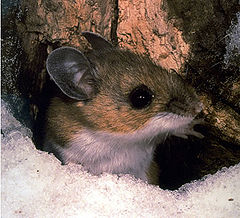
- Distribution: Maine, New Hampshire, Vermont, Massachusetts, northern Connecticut, and northern Rhode Island.
- Subspecies: Peromyscus maniculatus abietorum (northern Maine), Peromyscus maniculatus gracilis (southern and eastern Maine, New Hampshire, Vermont, Massachusetts, northern Connecticut, and northern Rhode Island) according to Hall (1981). Whitaker and Hamilton (1998) treat all New England forms of Peromyscus maniculatus as Peromyscus maniculatus maniculatus.
Southern Red-backed VoleSouthern Red-backed VoleThe Southern Red-backed Vole or Gapper's Red-backed Vole is a small slender vole found in Canada and the northern United States...
, Myodes gapperi
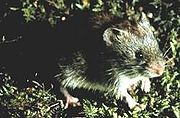
- Distribution: Maine, New Hampshire, Vermont, Massachusetts, northern Connecticut, and Rhode Island.
- Subspecies: Myodes gapperi ochraceous (Maine, New Hampshire, Vermont, eastern Massachusetts, Rhode Island) and Myodes gapperi gapperi (northern Connecticut) according to Hall (1981). Whitaker and Hamilton (1998) treat all New England forms of Myodes gapperi as Myodes gapperi gapperi.
Rock VoleRock VoleThe Rock Vole is a medium-sized vole found in eastern North America. It is also called the Yellow-nosed Vole....
, Microtus chrotorrhinus
- Distribution: northern Maine, northern New Hampshire, and northern Vermont.
- Subspecies: Microtus chrotorrhinus chrotorrhinusaccording to Hall (1981) and Whitaker and Hamilton (1998).
Meadow VoleMeadow VoleThe Meadow Vole , sometimes called the Field Mouse or Meadow Mouse, is a North American vole found across Canada, Alaska and the northern United States. Its range extends further south along the Atlantic coast. One subspecies, the Florida Salt Marsh Vole , is found in Florida, and is classified as...
, Microtus pennsylvanicus

- Distribution: Maine, New Hampshire, Vermont, Massachusetts, Connecticut, and Rhode Island.
- Subspecies: Microtus pennsylvanicus pennsylvanicus (Maine, New Hampshire, Vermont, Massachusetts, Connecticut, and Rhode Island) Microtus pennsylvanicus shattucki (Tumble Down Dick Island and Isleboro Island, Maine) according to Hall (1981) and Whitaker and Hamilton (1998).
Woodland VoleWoodland VoleThe Woodland Vole, Microtus pinetorum, is a small vole found in eastern North America. It is also known as the Pine Vole.-Description:...
, Microtus pinetorum
- Distribution: southernmost Maine, southern New Hampshire, southern Vermont, Massachusetts, Connecticut, and Rhode Island.
- Subspecies: Microtus pinetorum scalopsoides according to Hall (1981). Whitaker and Hamilton (1998) recognizes all New England Microtus pinetorum as Microtus pinetorum pinetorum.
MuskratMuskratThe muskrat , the only species in genus Ondatra, is a medium-sized semi-aquatic rodent native to North America, and introduced in parts of Europe, Asia, and South America. The muskrat is found in wetlands and is a very successful animal over a wide range of climates and habitats...
, Ondatra zibethicus

- Distribution: Maine, New Hampshire, Vermont, Massachusetts, Connecticut, and Rhode Island.
- Subspecies: Ondatra zibethicus zibethicus according to Hall (1981) and Whitaker and Hamilton (1998).
Northern Bog LemmingNorthern Bog LemmingThe Northern Bog Lemming, Synaptomys borealis is a small North American lemming. This is one of two species in genus Synaptomys, the other being the Southern Bog Lemming....
, Synaptomys borealis
- Distribution: northern and eastern Maine, northern New Hampshire, and extreme northeastern Vermont.
- Subspecies: Synaptomys borealis sphagnicola according to Hall (1981) and Whitaker and Hamilton (1998).
- Status: Threatened in Maine (Whitaker and Hamilton, 1998).
Southern Bog LemmingSouthern Bog LemmingThe Southern Bog Lemming, Synaptomys cooperi is a small North American lemming. Its range overlaps with the other species in genus Synaptomys, the Northern Bog Lemming, in southeastern Canada but extends further south....
, Synaptomys cooperi
- Distribution: Maine, New Hampshire, Vermont, Massachusetts, Connecticut, and Rhode Island.
- Subspecies: Synaptomys cooperi cooperi according to Hall (1981) and Whitaker and Hamilton (1998).
Brown RatBrown RatThe brown rat, common rat, sewer rat, Hanover rat, Norway rat, Brown Norway rat, Norwegian rat, or wharf rat is one of the best known and most common rats....
, Rattus norvegicus (introduced)
- Distribution: Maine, New Hampshire, Vermont, Massachusetts, Connecticut, and Rhode Island.
Black RatBlack RatThe black rat is a common long-tailed rodent of the genus Rattus in the subfamily Murinae . The species originated in tropical Asia and spread through the Near East in Roman times before reaching Europe by the 1st century and spreading with Europeans across the world.-Taxonomy:The black rat was...
, Rattus rattus (introduced)
- Distribution: extreme southern Maine, southeastern New Hampshire, eastern Massachusetts, all but northwestern Connecticut, and Rhode Island.
House MouseHouse mouseThe house mouse is a small rodent, a mouse, one of the most numerous species of the genus Mus.As a wild animal the house mouse mainly lives associated with humans, causing damage to crops and stored food....
, Mus musculus (introduced)
- Distribution: Maine, New Hampshire, Vermont, Massachusetts, Connecticut, and Rhode Island.
Porcupines, family ErethizontidaeNew World porcupineThe New World porcupines, or Erethizontidae, are large arboreal rodents, distinguished by the spiny covering from which they take their name. They inhabit forests and wooded regions across North America, and into northern South America...
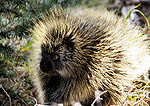
North American PorcupineNorth American PorcupineThe North American Porcupine , also known as Canadian Porcupine or Common Porcupine, is a large rodent in the New World porcupine family. The Beaver is the only rodent larger than the North American Porcupine found in North America...
, Erethizon dorsatum
- Distribution: Maine, New Hampshire, Vermont, western Massachusetts, and extreme northeastern Connecticut.
- Subspecies: Erethizon dorsatum dorsatum according to Hall (1981) and Whitaker and Hamilton (1998).
CoyoteCoyoteThe coyote , also known as the American jackal or the prairie wolf, is a species of canine found throughout North and Central America, ranging from Panama in the south, north through Mexico, the United States and Canada...
, Canis latrans

- Distribution: Maine, New Hampshire, Vermont, Massachusetts, Connecticut, and Rhode Island.
- Subspecies: Canis latrans thamnos according to Hall (1981). Wozencraft (2005) also recognizes C. l. thanos as a valid subspecies. Whitaker and Hamilton (1998) recognize all New England Canis latrans as Canis latrans latrans.
Gray WolfGray WolfThe gray wolf , also known as the wolf, is the largest extant wild member of the Canidae family...
Canis lupus (extirpated)
- Distribution (before extirpation): Maine, New Hampshire, Vermont, Massachusetts, Connecticut, and Rhode Island.
- Subspecies (before extirpation): Canis lupus lycaon according to Hall (1981) and Whitaker and Hamilton (1998).
- Status: Federally EndangeredUnited States Fish and Wildlife Service list of endangered speciesThis list contains only the bird and mammal species described as endangered by the United States Fish and Wildlife Service. It contains species not only in the U.S. and its territories, but also species only found abroad. It does not contain fish, amphibians, reptiles, plants, or invertebrates,...
(Whitaker and Hamilton, 1998).
Domestic DogDogThe domestic dog is a domesticated form of the gray wolf, a member of the Canidae family of the order Carnivora. The term is used for both feral and pet varieties. The dog may have been the first animal to be domesticated, and has been the most widely kept working, hunting, and companion animal in...
, Canis familiaris (introduced)
- Distribution: Domestic Dogs can become feral or semi-feral throughout New England.
Red FoxRed FoxThe red fox is the largest of the true foxes, as well as being the most geographically spread member of the Carnivora, being distributed across the entire northern hemisphere from the Arctic Circle to North Africa, Central America, and the steppes of Asia...
, Vulpes vulpes

- Distribution: Maine, New Hampshire, Vermont, Massachusetts, Connecticut, and Rhode Island.
- Subspecies: Vulpes vulpes rubricosa (northern Maine) and Vulpes vulpes fulva (southern Maine, New Hampshire, Vermont, Massachusetts, Connecticut, and Rhode Island) according to Hall (1981). Whitaker and Hamilton (1998) do not recognize V. v. rubricosa as valid and recognize all New England Vulpes vulpes as V. v. fulva. Wozencraft (2005), however, does recognize V. v. rubricosa as a valid subspecies.
Gray FoxGray FoxThe gray fox is a mammal of the order Carnivora ranging throughout most of the southern half of North America from southern Canada to the northern part of South America...
, Urocyon cinereoargenteus
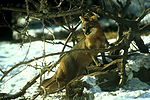
- Distribution: southern Maine, New Hampshire, Vermont, all but extreme southern Massachusetts, all but southeastern Connecticut, and northern Rhode Island.
- Subspecies: Urocyon cinereoargenteus borealis (Maine, New Hampshire, Vermont, and central Massachusetts) and Urocyon cinereoargenteus cinereoargenteus (all but southeastern Connecticut and northern Rhode Island) according to Hall (1981). Whitaker and Hamilton (1998) do not recognize U. c. borealis as valid and recognize all New England Urocyon cinereoargenteus as U. c. cinereoargenteus. Wozencraft (2005), however, does recognize U. c. borealis as a valid subspecies.
American Black BearAmerican black bearThe American black bear is a medium-sized bear native to North America. It is the continent's smallest and most common bear species. Black bears are omnivores, with their diets varying greatly depending on season and location. They typically live in largely forested areas, but do leave forests in...
, Ursus americanus
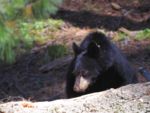
- Distribution: northern and central Maine, all but southeastern New Hampshire, all but northwestern Vermont, western and central Massachusetts, and northwestern Connecticut.
- Subspecies: Ursus americanus americanus according to Hall (1981) and Whitaker and Hamilton (1998).
Harbor SealHarbor SealThe harbor seal , also known as the common seal, is a true seal found along temperate and Arctic marine coastlines of the Northern Hemisphere...
, Phoca vitulina (coastal)
- Subspecies: Phoca vitulina concolor according to Hall (1981) and Folkens (2002).
Harp SealHarp SealThe harp seal or saddleback seal is a species of earless seal native to the northernmost Atlantic Ocean and adjacent parts of the Arctic Ocean. It now belongs to the monotypic genus Pagophilus. Its scientific name, Pagophilus groenlandicus, means "ice-lover from Greenland", and its synonym, Phoca...
, Pagophilus groenlandicus (potential coastal vagrant)
- Subspecies: Pagophilus groenlandicus groenlandicus according to Hall (1981) and Folkens (2002).
Common Raccoon, Procyon lotor
_2.jpg)
- Distribution: Maine, New Hampshire, Vermont, Massachusetts, Connecticut, and Rhode Island.
- Subspecies: Procyon lotor lotor according to Hall (1981) and Whitaker and Hamilton (1998).
Pine MartenAmerican MartenThe American marten is a North American member of the family Mustelidae, sometimes referred to as the pine marten. The name "pine marten" is derived from the common but distinct Eurasian species of Martes...
, Martes americana
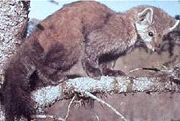
- Distribution: northern Maine, northern New Hampshire, and northern Vermont. Originally distributed throughout Maine, most of New Hampshire, and most of Vermont.
- Subspecies: Martes americana americana according to Hall (1981) and Whitaker and Hamilton (1998).
- Status: Endangered in Vermont; Threatened in New Hampshire.
WolverineWolverineThe wolverine, pronounced , Gulo gulo , also referred to as glutton, carcajou, skunk bear, or quickhatch, is the largest land-dwelling species of the family Mustelidae . It is a stocky and muscular carnivore, more closely resembling a small bear than other mustelids...
, Gulo gulo
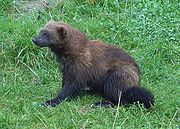
- Distribution: Maine, Vermont, New Hampshire, Massachusetts, and Connecticut.
- Subspecies: Gulo gulo according to Hall (1981) and Whitaker and Hamilton (1998).
FisherFisher (animal)The fisher is a medium-size mammal native to North America. It is a member of the mustelid family, commonly referred to as the weasel family. The fisher is closely related to but larger than the American Marten...
, Martes pennanti
.jpg)
- Distribution: Maine, New Hampshire, all but southwestern Vermont, most of Massachusetts, and northern Connecticut. Originally distributed throughout Maine, New Hampshire, Vermont, Massachusetts and northwestern Connecticut.
- Subspecies: Martes pennanti pennanti according to Hall (1981) and Whitaker and Hamilton (1998).
Short-tailed WeaselStoatThe stoat , also known as the ermine or short-tailed weasel, is a species of Mustelid native to Eurasia and North America, distinguished from the least weasel by its larger size and longer tail with a prominent black tip...
, Mustela erminea

- Distribution: Maine, New Hampshire, Vermont, Massachusetts, Connecticut, and Rhode Island.
- Subspecies: Mustela erminea cicognanii according to Hall (1981) and Whitaker and Hamilton (1998).
Long-tailed WeaselLong-tailed WeaselThe long-tailed weasel , also known as the bridled weasel or big stoat is a species of mustelid distributed from southern Canada throughout all the United States and Mexico, southward through all of Central America and into northern South America.-Evolution:The long-tailed weasel is the product of...
, Mustela frenata
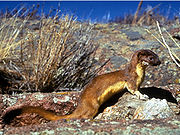
- Distribution: Maine, New Hampshire, Vermont, Massachusetts, Connecticut, and Rhode Island.
- Subspecies: Mustela frenata occisor (all but western Maine) and Mustela frenata noveboracensis (western Maine, New Hampshire, Vermont, Massachusetts, Connecticut, and Rhode Island) according to Hall (1981). Whitaker and Hamilton (1998) do not recognize both M. f. occisor and M. f. noveboracensis as valid and recognize all New England Mustela frenata as Mustela frenata frenata. Wozencraft (2005), however, does recognize both M. f. occisor and M. f. noveboracensis as valid subspecies.
American MinkAmerican MinkThe American mink is a semi-aquatic species of Mustelid native to North America, though human intervention has expanded its range to many parts of Europe and South America. Because of this, it is classed as Least Concern by the IUCN. Since the extinction of the sea mink, the American mink is the...
Neovison vison
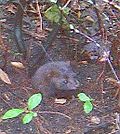
- Distribution: Maine, New Hampshire, Vermont, Massachusetts, Connecticut, and Rhode Island.
- Subspecies: Neovison vison vison (Maine, all but southernmost New Hampshire, and all but southernmost Vermont) and Neovison vison mink (southernmost New Hampshire, southernmost Vermont, Massachusetts, Connecticut, and Rhode Island) according to Hall (1981). Whitaker and Hamilton (1998) do not recognize N. v. mink as valid and recognize all New England Neovison vison as N. v. vison. Wozencraft (2005), however, does recognize N. v. mink as a valid subspecies.
Sea MinkSea MinkThe Sea Mink, Neovison macrodon, is an extinct North American member of the family Mustelidae. It is the only mustelid, and one of only two terrestrial mammal species in the order Carnivora, to become extinct in historic times . The body of the sea mink was significantly longer than that of the...
Neovison macrodon (extinct)
- Distribution (historic): eastern Massachusetts, extreme south eastern New Hampshire, and eastern Maine
River OtterNorthern River OtterThe North American river otter , also known as the northern river otter or the common otter, is a semiaquatic mammal endemic to the North American continent, found in and along its waterways and coasts. An adult river otter can weigh between 5 and 14 kg...
, Lontra canadensis
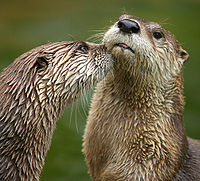
- Distribution: Maine, New Hampshire, Vermont, Massachusetts, northern Connecticut, and northern Rhode Island.
- Subspecies: Lontra canadensis canadensis according to Hall (1981) and Whitaker and Hamilton (1998).
Striped SkunkStriped SkunkThe striped skunk, Mephitis mephitis, is an omnivorous mammal of the skunk family Mephitidae. Found over most of the North American continent north of Mexico, it is one of the best-known mammals in Canada and the United States.-Description:...
, Mephitis mephitis
- Distribution: Maine, New Hampshire, Vermont, Massachusetts, Connecticut, and Rhode Island.
- Subspecies: Mephitis mephitis nigra according to Hall (1981). Wozencraft (2005) also recognizes M. m. nigra as a valid subspecies. Whitaker and Hamilton (1998) recognize all New England Mephitis mephitis as Mephitis mephitis mephitis.
Domestic CatCatThe cat , also known as the domestic cat or housecat to distinguish it from other felids and felines, is a small, usually furry, domesticated, carnivorous mammal that is valued by humans for its companionship and for its ability to hunt vermin and household pests...
, Felis catus (introduced)
- Distribution: Domestic Cats can become feral or semi-feral throughout New England.
Mountain Lion, Felis concolor (extirpated)
- Distribution (before extirpation): Maine, New Hampshire, Vermont, Massachusetts, Connecticut, and Rhode Island.
- Subspecies (before extirpation): Felis concolor couguar according to Hall (1981) and Whitaker and Hamilton (1998).
- Status: Federally Endangered (Whitaker and Hamilton (1998).
Canada LynxCanada LynxThe Canada lynx or Canadian lynx is a North American mammal of the cat family, Felidae. It is a close relative of the Eurasian Lynx . Some authorities regard both as conspecific. However, in some characteristics the Canada lynx is more like the bobcat than the Eurasian Lynx...
, Lynx canadensis
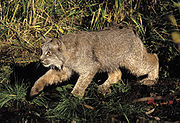
- Distribution: northern Maine, northern New Hampshire, and northern Vermont. Originally distributed throughout New England.
- Subspecies: Lynx canadensis canadensis according to Hall (1981) and Whitaker and Hamilton (1998).
- Status: Endangered in New Hampshire and Vermont (Whitaker and Hamilton, 1998).
BobcatBobcatThe bobcat is a North American mammal of the cat family Felidae, appearing during the Irvingtonian stage of around 1.8 million years ago . With twelve recognized subspecies, it ranges from southern Canada to northern Mexico, including most of the continental United States...
, Lynx rufus

- Distribution: Maine, New Hampshire, Vermont, northern Massachusetts, and northwestern Connecticut. Originally distributed throughout New England.
- Subspecies: Lynx rufus gigas (all but southernmost Maine, northern New Hampshire, and northern Vermont) and Lynx rufus rufus (southernmost Maine, southern New Hampshire, southern Vermont, northern Massachusetts, and northwestern Connecticut according to Hall (1981). Whitaker and Hamilton (1998) do not recognize L. r. gigas as valid and recognize all New England Lynx rufus as L. r. rufus. Wozencraft (2005), however, does recognize L. r. gigas as a valid subspecies.
- Status: Threatened in Rhode Island.
American ElkElkThe Elk is the large deer, also called Cervus canadensis or wapiti, of North America and eastern Asia.Elk may also refer to:Other antlered mammals:...
, Cervus elaphus (extirpated)
- Distribution (before extirpation): southern Vermont, western Massachusetts, and northwestern Connecticut.
- Subspecies (before extirpation): Cervus elaphus canadensis according to Hall (1981) and Whitaker and Hamilton (1998).
White-tailed DeerWhite-tailed DeerThe white-tailed deer , also known as the Virginia deer or simply as the whitetail, is a medium-sized deer native to the United States , Canada, Mexico, Central America, and South America as far south as Peru...
, Odocoileus virginianus
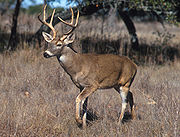
- Distribution: Maine, New Hampshire, Vermont, Massachusetts, Connecticut, and Rhode Island.
- Subspecies: Odocoileus virginianus borealis according to Hall (1981). Grubb (2005) also recognizes O. v. borealis as a valid subspecies. Whitaker and Hamilton (1998) recognize all New England Odocoileus virginianus as Odocoileus virginianus virginianus.
MooseMooseThe moose or Eurasian elk is the largest extant species in the deer family. Moose are distinguished by the palmate antlers of the males; other members of the family have antlers with a dendritic configuration...
Alces americanus
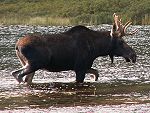
- Distribution: Maine, all but southeastern New Hampshire, Vermont, and northernmost Massachusetts.
- Subspecies: Alces americanus americanus according to Hall (1981) and Whitaker and Hamilton (1998).
North Atlantic Right WhaleNorth Atlantic Right WhaleThe North Atlantic right whale which means "good, or true, whale of the ice") is a baleen whale, one of three right whale species belonging to the genus Eubalaena, formerly classified as a single species. With only 400 in existence, North Atlantic right whales are among the most endangered whales...
, Eubalaena glacialis (coastal, pelagic)
West Indian ManateeWest Indian ManateeThe West Indian Manatee is a manatee, and the largest surviving member of the aquatic mammal order Sirenia . The West Indian Manatee, Trichechus manatus, is a species distinct from the Amazonian Manatee, T. inunguis, and the West African Manatee, T. senegalensis...
, Trichechus manatus (coastal vagrant)
- Subspecies: Trichechus manatus latirostris according to Folkens (2002).
See also
- List of mammals in Connecticut
- Fauna of ConnecticutFauna of ConnecticutThe Fauna of Connecticut comprise a variety of animal species.*The state bird is the American Robin.*The state insect is the European Mantis.*The state animal is the Sperm Whale.*The state shellfish is the Eastern Oyster....
- List of Massachusetts mammals
- List of North American mammals
- List of regional mammals lists

